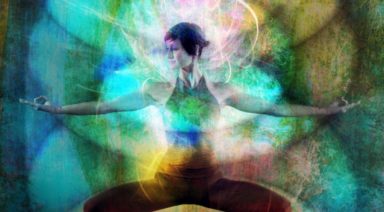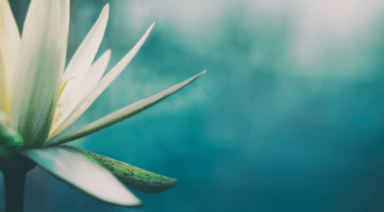Spinning the Seven Sacred Centers: Ayurveda And the Chakra

The popular seven chakra system is well known in the West. Chakra, meaning vortex or wheel, are the sacred centers of spiritual transformation. Everything from clothing, home décor, and oracle cards sport the seven subtle centers with their associated rainbow of colors. Popular western literature corresponds each of the chakras with a fundamental human need. The root chakra, or Muladhara, is associated with the need for survival.
The second chakra, Swadisthana, is associated with the need for emotional flow, desire, and sexuality. The third chakra, Manipuri, is associated with self-worth. The fourth chakra, Anahata, is associated with love. The fifth chakra, Vishudhi, is associated with the need for expression. The sixth chakra, Ajna, is associated with insight and intuition. And the 7th or crown chakra, Sahasrara, is associated with connection to the divine.
However, ancient scriptures on the chakras such as the 16th-century text, Sat Chakra Nirupama, do not associate the seven chakras with fundamental human needs. This association was, to my knowledge, first made by Carl Jung in a series of lectures that have been republished as “The Psychology of Kundalini Yoga”(1932).
Likewise, the association of rainbow colors (red for the 1st chakra, orange for the 2nd and so on up to purple at the crown) was made first in the 1970s in a book titled “Nuclear Evolution: Discovery of the Rainbow Body,” by Christopher Hills. Ancient Sanskrit and Tibetan texts on chakras and the subtle energetic body (also known as the Pranamayakosha) have various numbers of chakras and a variety of color schemes that do not follow the “ROYGBIV” rainbow-schema.
For better or worse, the seven chakra system has become reified in yogic culture; the seven chakras system is the “standard” system with which most students and teachers of yoga are familiar with. Many students and teachers of yoga may also have some familiarity with Ayurveda, the “Science of Life.” Ayurveda is a system of earth-based holistic medicine that was originally developed in ancient India but has evolved for contemporary application. Ayurveda uses three archetypal categories, called doshas, to understand balance in the body.
These categories are Vata, Pitta, and Kapha. Vata is like air and ether. It is light, dry, and cold, and responsible for everything in the body that moves, communicates, and transports. Pitta is like fire. It is hot and slightly damp. Pitta is responsible for digestion, metabolism, and transformation in the body. Finally, Kapha is similar to earth and water. It is slow and stable. Wet and cold. Kapha is responsible for our stability, immunity, and strength.
How do the Doshas Relate to the Chakras?
How do the doshas, Vata, Pitta, and Kapha, relate to the seven sacred charka centers? This is where we begin to blend the wisdom of Ayurveda, Vedic Astrology, and Yoga to understand the deep interconnections of our subtle, energetic, and physical bodies. Each of the three doshas (Vata, Pitta, Kapha) has five sub-doshas. These sub-dosha are specific areas of the mind-body that are governed by Vata, Pitta, or Kapha.
It is at the level of these fifteen sub-doshas that we can see correspondences with the chakra system. Because the physical, emotional, energetic, and mental bodies all layered one on top of another like an onion, this means that the physical body affects the energetic body; the layer of the Self where the chakras reside. The energetic body affects the mental/emotional bodies and so on.
Yoga students and practitioners and subtle body healers have long attributed the glandular system as having correspondences with the chakra system. In this model, each chakra corresponds to one of the body’s major glands, which aligns in similar locations to the seven chakra system.
In this way, the gonads correspond to the root chakra, the pancreas to the second chakra, the adrenals to the third chakra, the thymus gland to the heart chakra, the thyroid and parathyroid glands to the throat chakra, the pituitary gland to the third eye, and the pineal gland to the crown chakra. This model is a wonderful way to understand the possible connections between the physical body and the energetic body that contains the chakra. It does not, however, clarify the relationship between the chakra and the three primary doshas of Ayurveda.
Understanding the Sub-Doshas
In other to understand how the doshas correspond to the chakra, we must know something about the fifteen sub-doshas. It is not, however, necessary to understand each of the fifteen sub-dosha to understand their relationships to the chakras. Instead, we just need to understand the most essential sub-doshas and their relationships to the physical and energetic bodies.
First Chakra
Vata rules everything in the body that moves, communicates, and transports and governs the hollow spaces of the body. In this way, the colon and its energy are ruled by Vata dosha. The colon is, essentially an empty space whose job is to move waste out of the body. The specific sub-dosha that governs the energy of the colon is called Apana Vata. Apana Vata corresponds to the energy of the first chakra.
When there are problems with elimination then often times there is an emotional and energetic correspondence to the first chakra. Healing strategies for Apana Vata and the First Chakra include herbal therapies that encourage elimination such as Triphala, Ayurvedic Massage therapy (abhyanga), and essential oils such as sweet fennel and sweet orange.
Second Chakra
The second chakra is located in the pelvis where some of the largest bones of the body are located. In this way, the energy of the second chakra, Swadisthana, relates to Kapha Dosha which is responsible for our immunity, strength, and stability. The specific sub-dosha which relates to the second chakra is called Avalambaka Kapha; the sub-dosha that governs the energy of the lower back and pelvis.
Often if there is difficulty with the lower back it means we’re lacking support, emotionally, financially, or physically. This lack of emotional flow and support relates to the functioning of the second chakra. Healing strategies for the second chakra include movement therapy such as Tai Chi, dancing, and belly dancing. Emotional release techniques, oil massage, and Ayurvedic spa treatments.
Third Chakra
The third chakra, Manipuri, located at the navel relates to Pitta Dosha, which is responsible for our digestion, transformation, and metabolism. The energy sub-dosha Ranjaka Pitta corresponds to the energy of our liver. The third chakra can emotionally contain issues of self-worth and repressed anger.
In this same way the energy of the liver, Ayurvedically, can become “heated” when someone represses emotions or anger. Healing strategies for the third chakra and Ranjaka Pitta include deep relaxation, continuous oil pouring on the forehead (called Shirodhara), vigorous exercises such as martial arts, and ayurvedic spiritual mentoring around issues of shame and self-worth.
Fourth Chakra
The fourth chakra, Anahata, located at the heart also relates to the energy of Pitta Dosha, specifically the energy of Sadhaka Pitta, the sub-dosha that is responsible for the “flame” of our passion. This sub-dosha becomes imbalanced when we experience mild depression or an inability to find our true calling. Healing strategies for the fourth chakra include heart-based meditation, oil massage, especially around the heart center, and aromatherapy using rose oil and sandalwood oil.
Fifth Chakra
The fifth chakra, Vishudhi, the throat center corresponds to the energy of Udana Vata, the “wind” that governs speech, the throat, and breath. When this energy is out of balance we may experience stuttering, mumbling shyness, or disorders of the throat. Healing strategies for the fifth chakra include chanting mantras, singing kirtan, journaling, and the application of Nasya oil (nasal oil).
Sixth Chakra
The sixth chakra, Ajna, located at the center of the forehead relates to the energy of Alochaka Pitta, which rules sight, vision, and the eyes. When this center is out of balance we may experience vision problems or lack of insight. This chakra corresponds to our intuitive ability; our ability to see into the future clearly; our vision and our ability to manifest. When out of balance we may have difficulty focusing, have poor memory or nightmares. Healing strategies for the energy of the sixth chakra and Alochaka Pitta include the use of mandalas and yantras, coloring, creative visualization, and Shirodhara (pouring oil on the forehead).
Seventh Chakra
And, finally, the seventh chakra, Sahasrara, relates to the energy of Prana Vata, which rules the nervous system. When this energy is out of balance we may experience rigidity of belief, difficulty learning from experience, and integrating our experience. Healing strategies for the crown chakra include meditation, aromatherapy using orange, Bulgarian lavender, and bergamot. Shirodhara is also an effective remedy for the seventh chakra.
In order to experience true, radiant health and well-being, we need to have more than just the physical body in good working order. Our physical heart may be working fine, but if we are experiencing depression, we can not say that we actually are in “perfect health,” from an Ayurvedic perspective.
There are some ways we can remedy the energies of the chakra and the sub-doshas. Ayurvedically, we use specific herbal remedies, essential oils, marma points (similar to acupressure points), ayurvedic yoga, Healing Light Yoga, and traditional therapies like oil massage and oil pouring to create balance in the sub-dosha and the corresponding chakra. We also use a mantra (sound current), gemstones, and yagyas (Vedic astrological remedies) and spiritual mentoring to create balance throughout the physical, emotional, and subtle body centers.
Because health is holistic, involving mental, spiritual, physical, and emotional well-being, the chakras are a vital window into our physiological balance. They are also a conduit towards understanding our life’s path on earth; what we have come here to experience, know, and understand. The chakras are the guideposts to our largest life lessons and creating sustained balance throughout the chakra allows for spiritual awakening. This awakening of the spirit is the true aim of yoga and Ayurveda.
What Your Dosha Type Means for Your Diet

Ayurveda is Sanskrit for “the wisdom of life.” Ayurveda originated in India and pre-dates modern medicine by thousands of years.
Ayurveda healing differs from modern medicine in the following ways:
- Focuses on preventative techniques, instead of merely reacting to illness as it arises
- Diet and habits are more strongly considered when diagnosing and treating
- Emphasizes on the uniqueness of the individual and finding what works for you personally
Three Types of Ayurveda Doshas
There are three types of Ayurveda Doshas – kapha, pitta, and vata. Doshas are more commonly known as mind-body types and are derived from the five elements.
While we all have aspects of each of the three doshas, for most of us, there is one dosha that dominates. You can also be a combination of two doshas, but that is less frequent. Before you learn about the characteristics of each type of dosha, determine which one(s) are most pertinent to you by taking this quick quiz.
I took this quiz with a little bit of healthy skepticism, not expecting anyone dosha to be that much stronger than the others, but for me, the traits corresponding to vata dosha are twice as strong. There are several dosha quizzes online, all of which gave me similar results.
Once you determine which dosha pertains to you, read about the strengths and weaknesses of that dosha and what dietary changes you can make to keep yourself in better alignment. While this article focuses on dietary modifications, there are all sorts of supplements, lifestyle and yoga practices that are also beneficial.




































